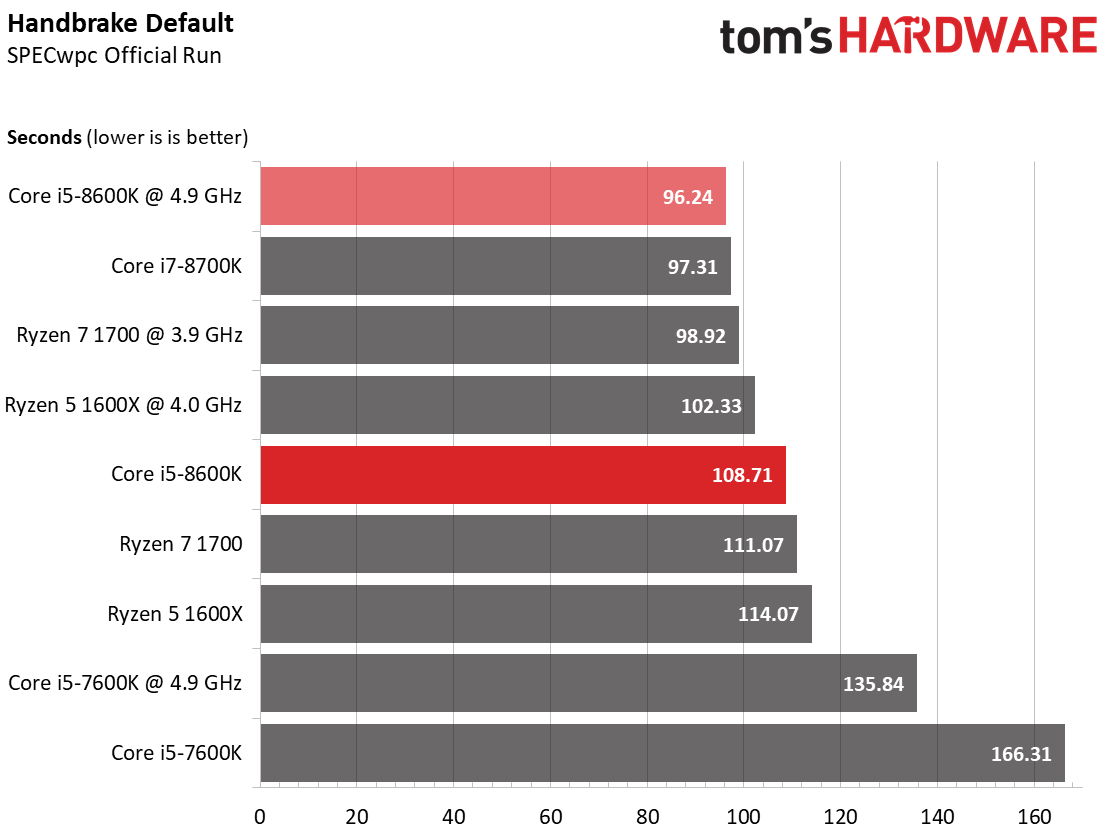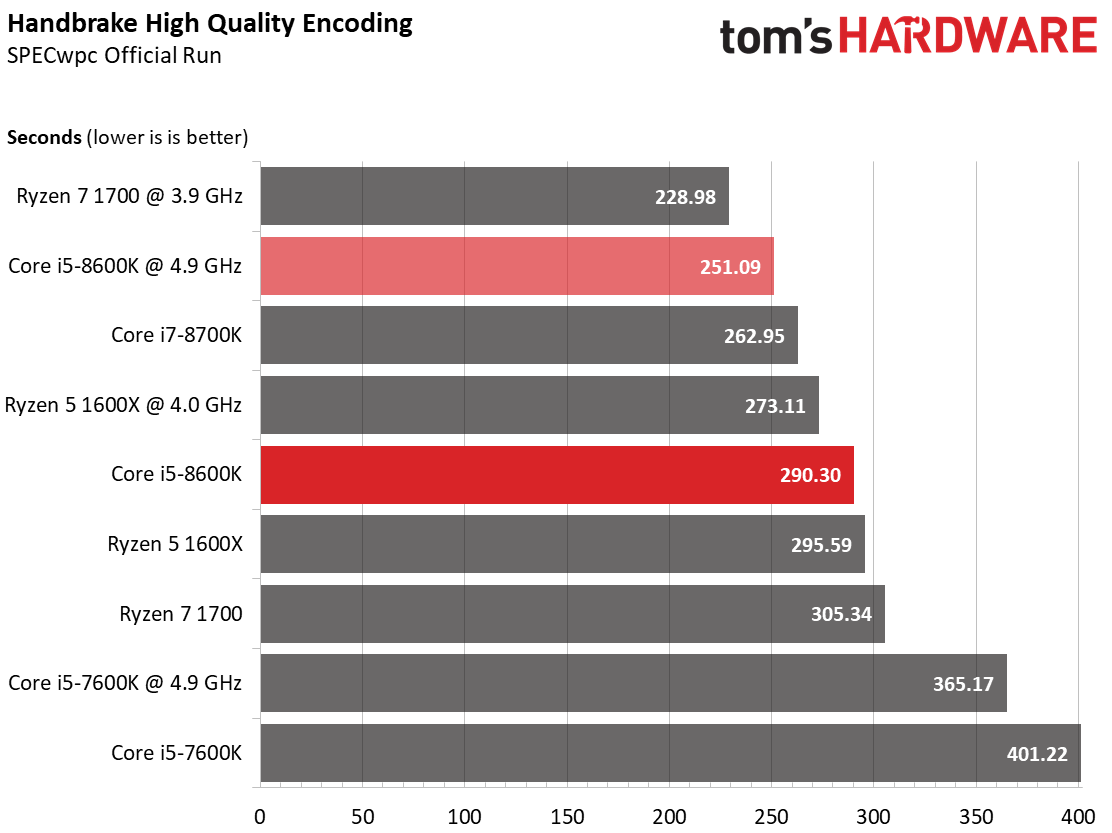Intel Core i5-8600K Review: Coffee Lake's Jolting Value
Why you can trust Tom's Hardware
DTP, Office, Multimedia & Compression
We ran the older Core i5-7600K through our application test suite at 4.9 GHz, while the U.S. lab was able to maintain 5 GHz for the game testing. This boils down to a difference in sample quality between our offices, reminding us that maximum overclock frequencies aren't guaranteed.
DTP and Presentation
Adobe’s Creative Cloud gives us a look at real-world single- and multi-threaded performance. As such, it beats synthetic benchmarks as a productivity test. After Effects CC is the classic example of a workload that prizes parallelism, so core count trumps clock frequencies.
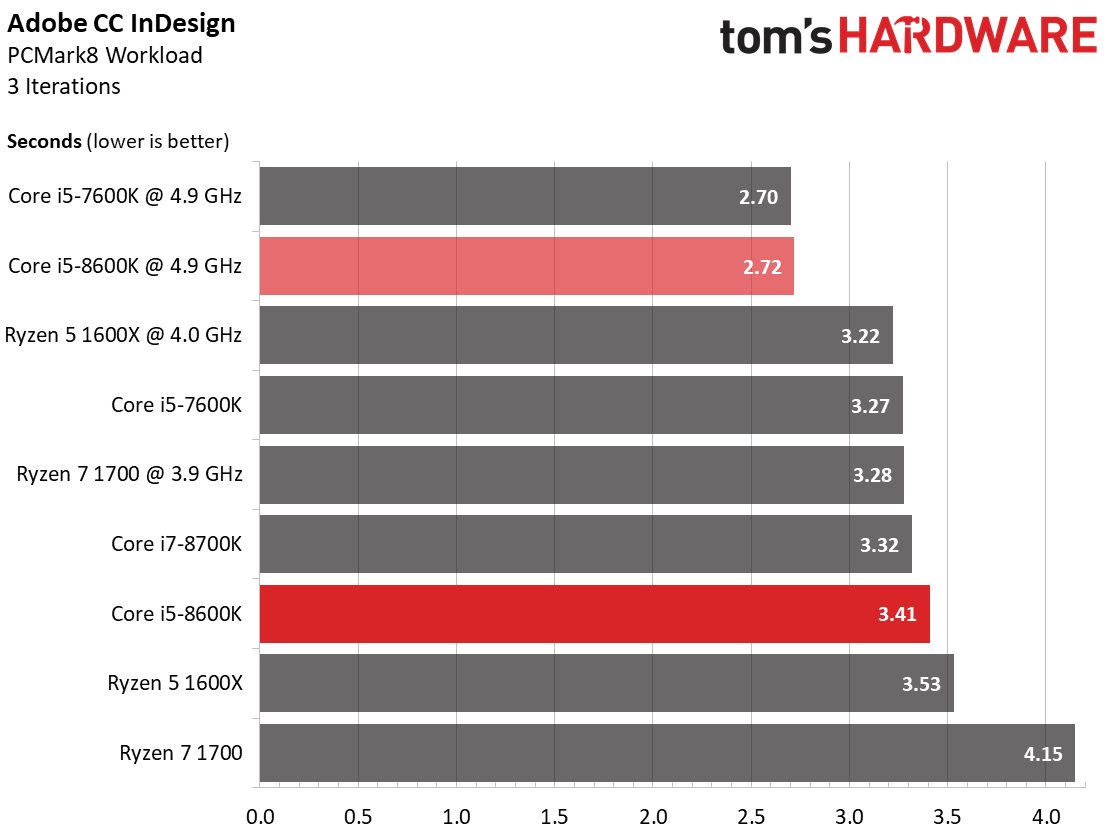
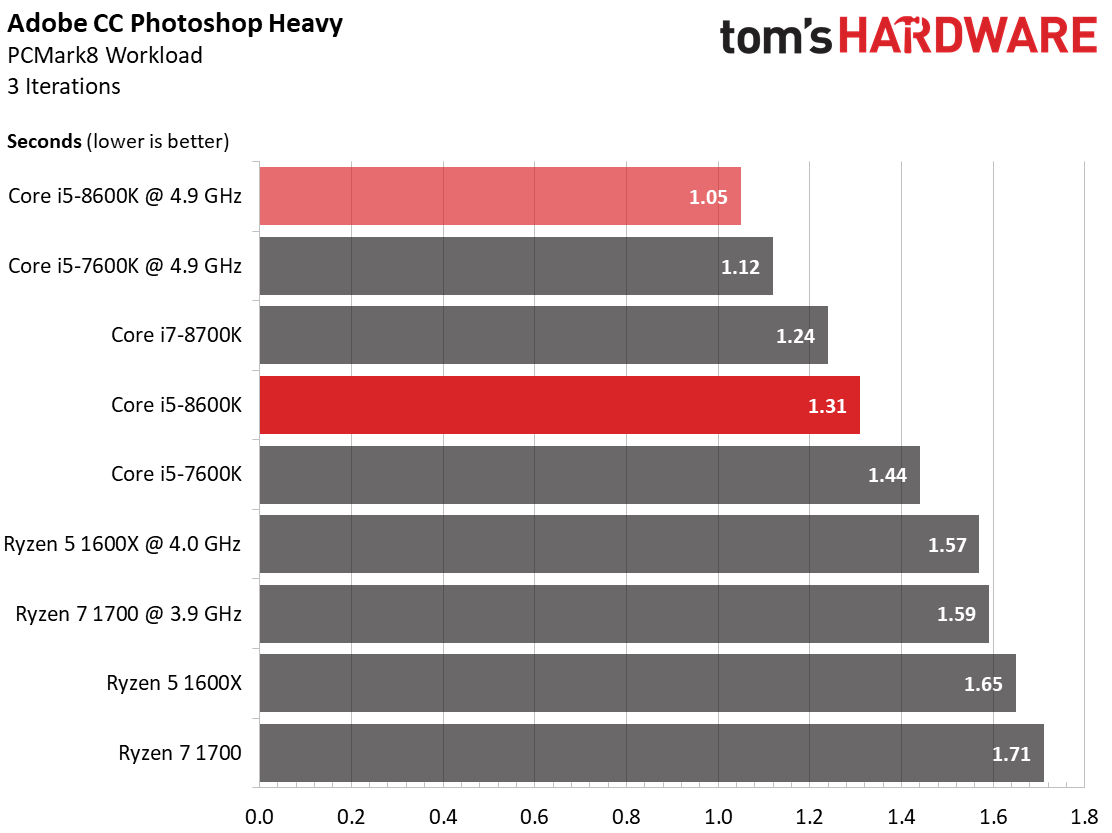
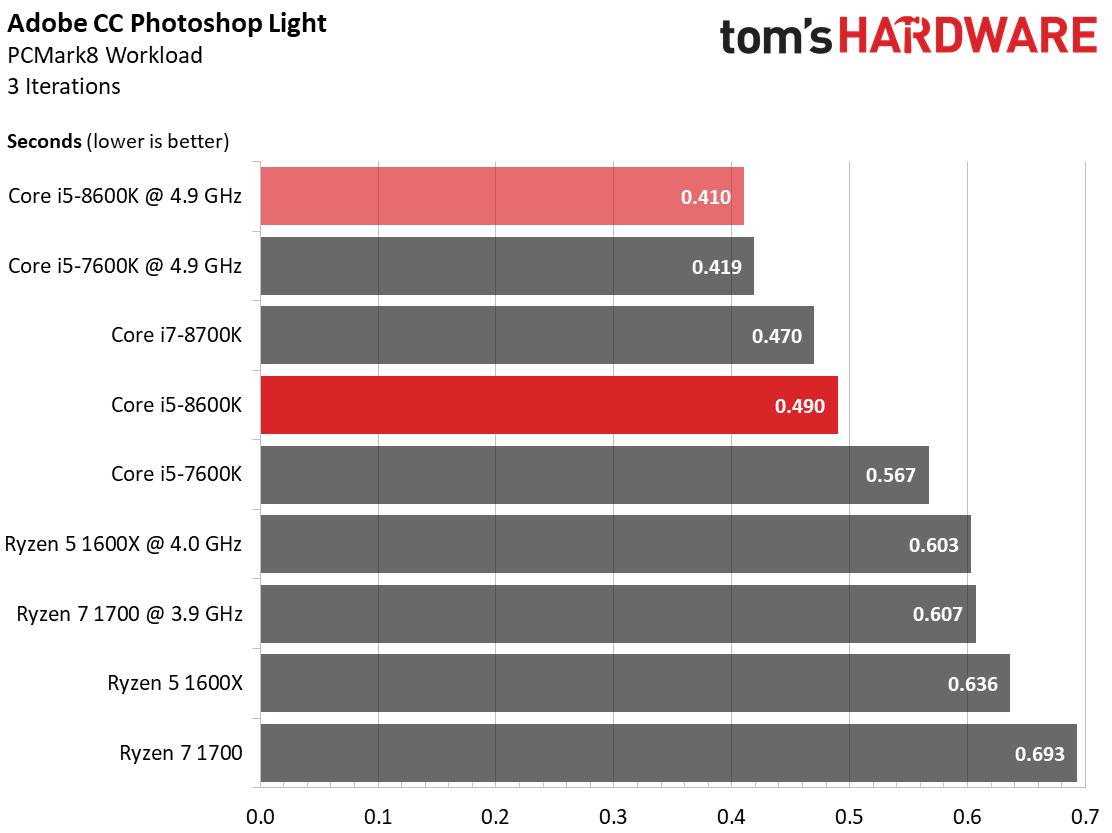
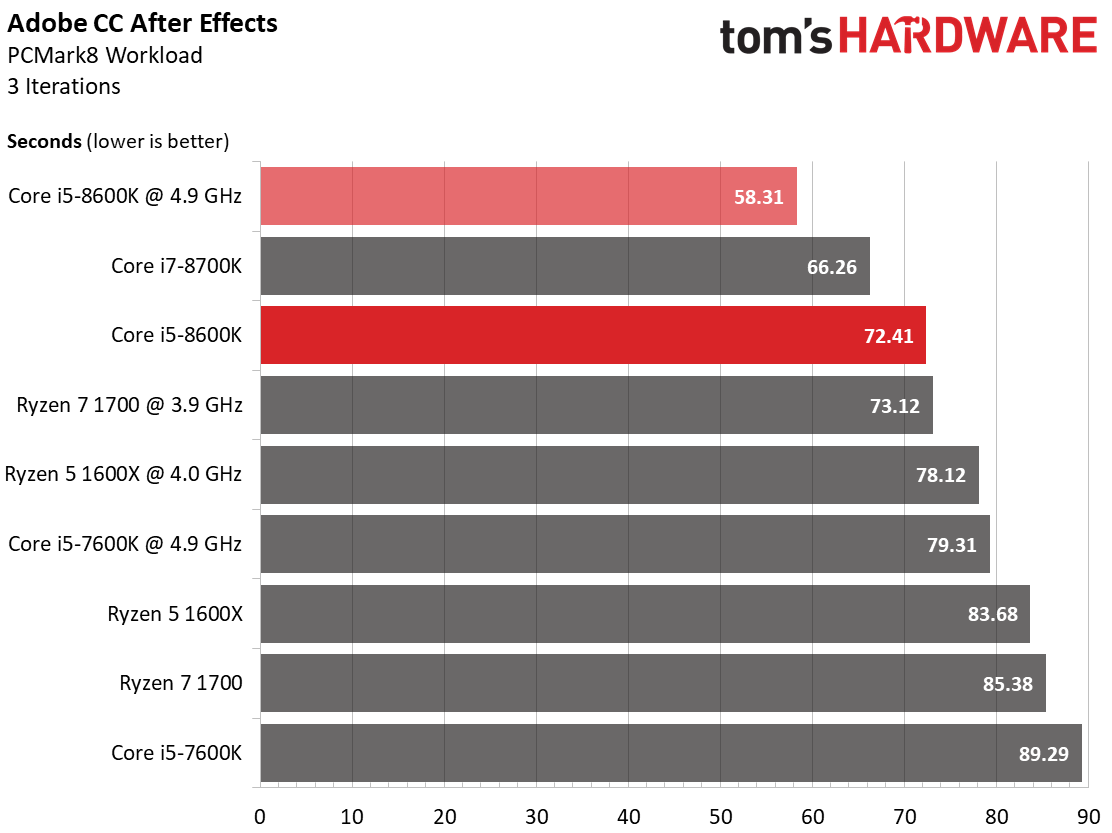
Overclocking helps propel Core i5-8600K out in front of the stock Core i7-8700K, though.
Meanwhile, in Adobe's InDesign CC, both Coffee Lake-based CPUs fall behind a stock Core i5-7600K. Presumably, this is another instance where higher clock rates in lightly-threaded tasks reign.
Encoding and Multimedia
The stock Core i5-8600K dominates every other CPU except for Intel's Core i7-8700K at default settings during SPECwpc's default HandBrake test.
Overclocking naturally changes the landscape quite a bit, helping a couple of Ryzen CPUs compete more aggressively. Then again, at 4.9 GHz, the -8600K lands in first place ahead of those tuned Ryzens.
The more taxing high-quality benchmark asks more from the field, allowing AMD's overclocked Ryzen 7 1700 to slide in ahead of Core i5-8600K at 4.9 GHz.
Get Tom's Hardware's best news and in-depth reviews, straight to your inbox.
Core i7-8700K doesn't need overclocking to achieve compelling performance. It's flying high on Hyper-Threading. Just imagine that processor running at the same 4.9 GHz we used in our review.
MORE: Best CPUs
MORE: Intel & AMD Processor Hierarchy
MORE: All CPUs Content
Current page: DTP, Office, Multimedia & Compression
Prev Page Project CARS, Far Cry Primal & Rise of the Tomb Next Page Workstation 2D & 3D Performance
Paul Alcorn is the Editor-in-Chief for Tom's Hardware US. He also writes news and reviews on CPUs, storage, and enterprise hardware.
-
logainofhades Great CPU, but the overall platform cost is a bit of a turn off, for me. I'd rather get a 1600, and a B350 board, to allow for a better GPU, if buying new. As stated in the review, even a 1700, with a less expensive board, is a very compelling option.Reply
-
AS118 Seems like a good product, but I'd like to see what the 8600 and 8500 non-k offers, and perhaps next year with the B360 boards that give them a more budget "locked cpu" option.Reply
I also feel that the availability will be low for Coffee Lake until the end of this year, particularly throughout the holiday season. Due to that concern (as well as the total cost of platform ownership) I think that Ryzen with its 1600 and 1700 CPU's along with the 1600x will be the value kings this year, with Coffee Lake not hitting it's stride until early next year.
The fact that AMD's stuff doesn't have the same availability issues makes it a strong contender, imho, although Black Friday and Christmas sales will also like make Kaby Lake (and even Sky Lake) stuff at clearance prices appealing too, despite the lack of cores you'll find in Ryzen and now Coffee Lake. -
almostdecent Since the chart shows the i5-8600k and the i5-8600K@4.9GHz at the same $260, I presume that means you achieved the overclock with the stock cooler.Reply -
ammaross It's kind of disappointing to see so many benchmarks where an i5 does as well or better than it's i7 counterpart. It just shows how poorly threaded some of these applications really are and almost necessitates running two benchmarks simultaneously to really judge the merit of these multi-core CPUs. Maybe run the photoshop test while rendering with After Effects or run a game benchmark while doing CPU h.265 handbrake.Reply -
almostdecent It is worth mentioning that this is essentially a paper launch at the moment, since none of the Coffee Lake processors are available anywhere.Reply
http://www.nowinstock.net/computers/processors/intel/
and the rare place that has any, such as Microcenter, have gouging prices. Such as selling the plain i7-8700 (not the K version) with an MSRP of $300 for sale for $429.
http://www.microcenter.com/product/486087/Core_i7-8700_Coffee_Lake_32_GHz_LGA_1151_Boxed_Processor -
InvalidError Reply
On September 20, Intel responded to a story about yet another 10nm schedule slip by saying that Cannon Lake will begin shipping in limited quantities to some laptop manufacturers with production ramping up in 1H2018. Limited Coffee Lake volume could be due to Intel deciding to upgrade production lines to 10nm for Cannon Lake instead of 14++.20281291 said:I also feel that the availability will be low for Coffee Lake until the end of this year, particularly throughout the holiday season. -
TJ Hooker Reply
Not sure if you were being sarcastic, but the 8600K doesn't have a stock cooler.20281420 said:Since the chart shows the i5-8600k and the i5-8600K@4.9GHz at the same $260, I presume that means you achieved the overclock with the stock cooler.
There are two different sets of graphs, one that looks at CPU only costs and the other that considers CPU, mobo, and cooler costs. In the latter, the 8600K at 4.9GHz is clearly shown to cost more.
-
InvalidError Reply
Intel hasn't included a stock HSF with their unlocked CPUs since Skylake so on top of paying more for the unlock, you also get shafted by the price of a stock cooler which you no longer get on top of it. You need an aftermarket cooler for both stock and OC.20281420 said:Since the chart shows the i5-8600k and the i5-8600K@4.9GHz at the same $260, I presume that means you achieved the overclock with the stock cooler.
Same thing with AMD's Ryzen nnnnX CPUs. -
YoAndy Reply20281216 said:Great CPU, but the overall platform cost is a bit of a turn off, for me. I'd rather get a 1600, and a B350 board, to allow for a better GPU, if buying new. As stated in the review, even a 1700, with a less expensive board, is a very compelling option.
A better GPU?//Why would you do that. at 1080p Ryzen will (bottleneck) hold back powerful GPU's, It won't give you equal performance. I bought a Ryzen for pure gaming and i ended up selling it.. -
acosta.87 Reply20281216 said:Great CPU, but the overall platform cost is a bit of a turn off, for me. I'd rather get a 1600, and a B350 board, to allow for a better GPU, if buying new. As stated in the review, even a 1700, with a less expensive board, is a very compelling option.
B350 VRM's are pretty low quality for any sort of OC unless it's a mild one so for me that's a no go. If you're primarily into gaming then the 1600 has nothing on the i5, it simply trails it whether at stock settings or OC'd and even at productivity it beats a 1600 Ryzen processors in most task even with a 6 thread deficit so it's a pretty good investment overall.
